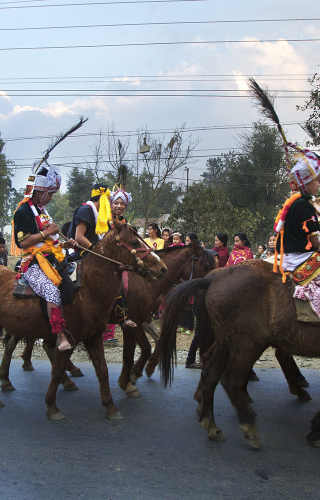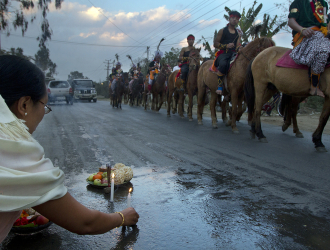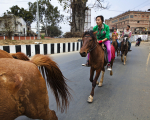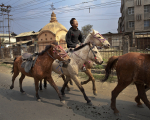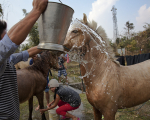I heard about the Manipuri Pony in 2013 from L. Somi Roy, a cultural conservationist from Manipur, and was immediately intrigued when I was told that it was the world's original polo pony, as Manipur has been recognized as the birthplace of the modern game. I learned that it was one of five equine breeds in the country, probably descended from the celebrated Mongolian Pony, and that it was a warrior horse, enshrined in myth, worshipped in ritual and eulogized in song. I love to photograph horses, so it didn’t take much persuasion from Roy to get me there, and see first-hand how an animal that traditionally had such an elevated status in Manipuri culture was now roaming on the streets, reduced to eating garbage.
The traditional way of rearing ponies on shared commons, often a marshy lake bed, was destroyed by rapid urbanization that left the semi-feral animals without a home for grazing and breeding. I wanted to explore Manipur’s unique equestrian culture, and its 'pony imprints’ in different aspects of culture, society and the economy. In traditional Manipuri society, the ponies' lofty status ensured that they were emplpyed only for sport, ritual and war, not as workhorses. The dozen or so polo fields dotting the valley of the erstwhile kingdom of the Meiteis show that even now polo is an egalitarian sport here—played even at a village level. The images in this photo essay cover the different aspects of the sport and the role of the pony in contemporary Manipuri society. It covers the pony shrine of Lord Marjing, the god of polo at Heingang, a new preserve being built for conservation of the animals, the famous freshwater Loktak Lake from where much of the pony fodder is sourced, and finally international polo matches that are expanding awareness about the endangered Manipuri pony.
Roy told me how in the mid-19th century, when a boy-king of Manipur was in exile in neighboring Assam, some East India Company soldiers and planters from the tea estates, witnessed the king’s retinue play traditional Manipuri sagol kangjei or ‘horse hockey’ as they first dubbed it. The British adventurers joined in, and the world's first polo club, the Silchar Kangjei Club, was established in 1859. The game then spread to Calcutta, and from there to Britain, where they decided to write down some rules for this game at the prestigious Hurlingham Club, and call it polo. Now at all polo tournaments in Imphal, there is a permanent sign that says 'Manipur, the Birthplace of Modern Polo'.
The state has found an innovative way to raise awareness about the importance of Manipuri ponies, and the need to preserve them—through international polo tournaments—where all the teams have to play on the indigenous ponies. Along with these efforts from the government bodies, Roy has partnered with the United States Polo Association (USPA), to bring in the heft of American polo to heighten awareness and elevate the game in Manipur by introducing goal-handicapped polo. They have also started coaching clinics for Manipuri men and women players. This has led to the promotion of women’s polo in the state, and in turn, the development of the first and only women's international polo tournament in the country. Currently, about two-thirds of the women polo players in India hail from Manipur.
With its singular and distinguished polo tradition resting on a unique equestrian culture, Manipur is emerging as a centre of polo in India for the international age.
